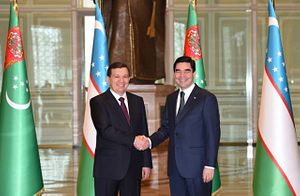Uzbek President Shavkat Mirziyoyev just finished his first trip abroad — to Turkmenistan — since officially taking the helm in Tashkent in December. While the requisite pile of papers were signed, diplomatic phrases exchanged, and obligatory tour of the Akhal-Teke horse-breeding complex completed — the trip is just the Turkmen tip of Mirziyoyev’s regional reengagement plan, which has seen measurable progress in Tajikistan, Kazakhstan and Kyrgyzstan.
Uzbekistan, as the only Central Asian state to share borders with every other regional state (plus Afghanistan), has long had difficult relations with most of its neighbors, in no small part because of former President Islam Karimov’s strained personal relations with the region’s other leaders. At the geographic and cultural heart of Central Asia, with the largest regional population at over 30 million, Uzbekistan and Karimov had plenty of weight to throw around.
It’s likely come as a relief to the region’s other states that Mirziyoyev’s good neighborliness seems to be more than just an opening overture.
In Ashgabat, Mirziyoyev and Turkmen President Gurbanguly Berdimuhamedov agreed to focus greater cooperation in the fields of energy and transportation. They signed a treaty on strategic cooperation and an agreement on economic cooperation, among other documents. On March 7, the two traveled to Lebap province, which makes up a significant portion of the two countries’ border, to attend the inauguration of a railway and road bridge across the Amu-Darya river.
All of this is fairly standard fare for bilateral meetings but is nonetheless a good sign.
The focus on energy and transportation reflects the concerns of both countries — Uzbekistan’s desire to access markets and need of outwardly branching infrastructure to do so and Turkmenistan’s overwhelming need for any kind of cash flow. While Uzbekistan’s active participation in regional affairs is welcome, it will not necessarily move all the initiatives mentioned along. One project highlighted by the presidents — a scheme to deliver electricity from Central Asia to South Asia (no, not CASA-1000 but a similar project, the Turkmenistan-Uzbekistan-Tajikistan-Afghanistan-Pakistan, or TUTAP, project) — demonstrates this point.
TUTAP made Central and South Asian headlines in 2016, but not for good reasons. As with other trans-regional projects — like CASA-1000 and TAPI — the TUTAP project is envisioned to cross Afghanistan. Last Spring, Hazaras in Afghanistan protested in response to announced changes to the TUTAP route moving the line out of Bamyan and to the Salang pass. Many among the Hazaras, an ethnic minority in Afghanistan who live predominantly in the central regions like Bamyan, viewed the path change as a deliberate move to cut them out of the promised energy supply and accompanying prosperity.
Renewed enthusiasm for the project on the part of Uzbekistan will not solve the project’s political problems in Afghanistan. Still, emphasizing TUTAP’s potential with Ashgabat may take some of the sting off recent news regarding another energy project.
EurasiaNet noted, “All the goodwill in the world may not be enough” to bring the Central Asia-China Line D project back to life. Last week, news broke that the pipeline’s fourth branch, intended to be the largest, was indefinitely delayed by the Uzbeks and the Chinese — likely much to Turkmenistan’s chagrin.

































